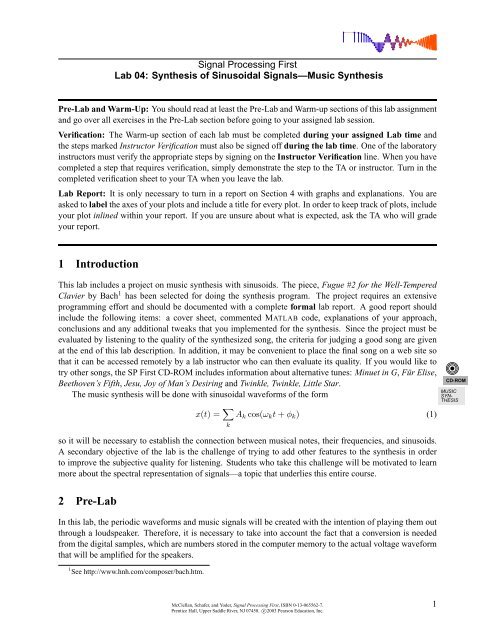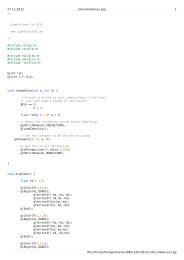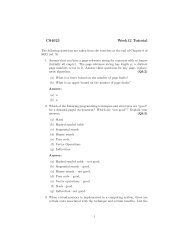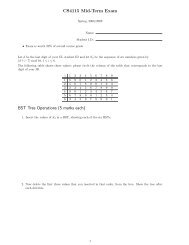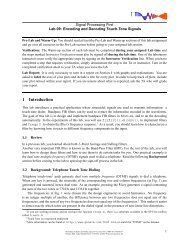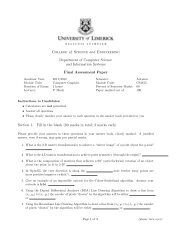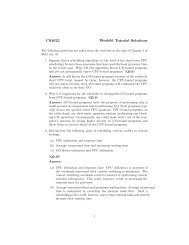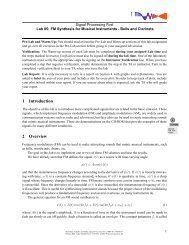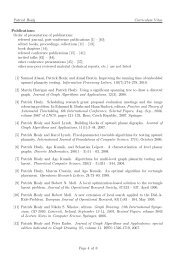Synthesis of Sinusoidal Signals - Music Synthesis
Synthesis of Sinusoidal Signals - Music Synthesis
Synthesis of Sinusoidal Signals - Music Synthesis
You also want an ePaper? Increase the reach of your titles
YUMPU automatically turns print PDFs into web optimized ePapers that Google loves.
2.5 Piano KeyboardSection 4 <strong>of</strong> this lab will consist <strong>of</strong> synthesizing the notes <strong>of</strong> a well known piece <strong>of</strong> music. 3 Since thesesignals require sinusoidal tones to represent piano notes, a quick introduction to the frequency layout <strong>of</strong> thepiano keyboard is needed. On a piano, the keyboard is divided into octaves—the notes in one octave beingtwice the frequency <strong>of</strong> the notes in the next lower octave. For example, the reference note is the A aboveOCTAVE41 43C 3 D 3 E 3 F 3 G 3 A 3 B 3 C 4 D 4 E 4 F 4 G 4 A 4 B 4 C 5 D 5 E 5 F 5 G 5 A 5 B 528 30 32 33 35 37 39 40 42 44 45 47 49 51 52 54 56 57 59 61 63Middle-C A-440Figure 2: Layout <strong>of</strong> a piano keyboard. Key numbers are shaded. The notation C 4 means the C-key in thefourth octave.middle-C which is usually called A-440 (or A 4 ) because its frequency is 440 Hz. (In this lab, we are usingthe number 40 to represent middle C. This is somewhat arbitary; for instance, the <strong>Music</strong>al Instrument DigitalInterface (MIDI) standard represents middle C with the number 60). Each octave contains 12 notes (5 blackkeys and 7 white) and the ratio between the frequencies <strong>of</strong> the notes is constant between successive notes.As a result, this ratio must be 2 1/12 . Since middle C is 9 keys below A-440, its frequency is approximately261 Hz. Consult chapter 9 for even more details.<strong>Music</strong>al notation shows which notes are to be played and their relative timing (half, quarter, or eighth).Figure 3 shows how the keys on the piano correspond to notes drawn in musical notation. The white keysare all labeled as A, B, C, D, E, F , and G; but the black keys are denoted with “sharps” or “flats.” A sharpsuch as A # is one key number larger than A; a flat is one key lower, e.g., A ♭ 4 is key number 48.TREBLEF-SHARPEIGHTH NOTE42 4446 47D 4E 4F# 4G 4A 4 = (A-440)49 51 52 54D 5AB C 4 5440C 4 (middle-C)BASSHALF NOTEQUARTER NOTE39 37 35 34 32B 303 A3 28G3 27F# 3 E3 D 3 C3 B 2Figure 3: <strong>Music</strong>al notation is a time-frequency diagram where vertical position indicates which note is to beplayed. Notice that the shape <strong>of</strong> the note defines it as a half, quarter or eighth note, which in turn defines theduration <strong>of</strong> the sound.3 If you have little or no experience reading music, don’t be intimidated. Only a little music knowledge is needed to carry out thislab. On the other hand, the experience <strong>of</strong> working in an application area where you must quickly acquire knowledge is a valuableone. Many real-world engineering problems have this flavor, especially in signal processing which has such a broad applicabilityin diverse areas such as geophysics, medicine, radar, speech, etc.McClellan, Schafer, and Yoder, Signal Processing First, ISBN 0-13-065562-7.Prentice Hall, Upper Saddle River, NJ 07458. c○2003 Pearson Education, Inc.5
Another interesting relationship is the ratio <strong>of</strong> fifths and fourths as used in a chord. Strictly speaking thefifth note should be 1.5 times the frequency <strong>of</strong> the base note. For middle-C the fifth is G, but the frequency<strong>of</strong> G is about 392 Hz which is not exactly 1.5 times 261.6. It is very close, but the slight detuning introducedby the ratio 2 1/12 gives a better sound to the piano overall. This innovation in tuning is called “equallytempered”or “well-tempered” and was introduced in Germany in the 1760’s and made famous by J. S. Bachin the “Well Tempered Clavier,” which is the source <strong>of</strong> the song for this lab.You can use the ratio 2 1/12 to calculate the frequency <strong>of</strong> notes anywhere on the piano keyboard. Forexample, the E-flat above middle-C (black key number 43) is 6 keys below A-440, so its frequency shouldbe f 43 = 440 × 2 −6/12 = 440/ √ 2 ≈ 311 Hertz.3 Warm-up3.1 Note Frequency FunctionNow write an M-file to produce a desired note for a given duration. Your M-file should be in the form <strong>of</strong> afunction called key2note.m. Your function should have the following form:function xx = key2note(X, keynum, dur)% KEY2NOTE Produce a sinusoidal waveform corresponding to a% given piano key number%% usage: xx = key2note (X, keynum, dur)%% xx = the output sinusoidal waveform% X = complex amplitude for the sinusoid, X = A*exp(j*phi).% keynum = the piano keyboard number <strong>of</strong> the desired note% dur = the duration (in seconds) <strong>of</strong> the output note%fs = 11025; %-- or use 8000 Hztt = 0:(1/fs):dur;freq =%
scale.durations = 0.25 * ones(1,length(scale.keys));fs = 11025; %-- or 8000 Hzxx = zeros(1, sum(scale.durations)*fs+length(scale.keys) );n1 = 1;for kk = 1:length(scale.keys)keynum = scale.keys(kk);tone =n2 = n1 + length(tone) - 1;xx(n1:n2) = xx(n1:n2) + tone;n1 = n2 + 1;endsoundsc( xx, fs )%
4 Lab Exercise: <strong>Synthesis</strong> <strong>of</strong> <strong>Music</strong>al NotesThe audible range <strong>of</strong> musical notes consists <strong>of</strong> well-defined frequencies assigned to each note in a musicalscore. Five different pieces are given in the book, but we have chosen a different one for the synthesisprogram in this lab. Before starting the project, make sure that you have a working knowledge <strong>of</strong> therelationship between a musical score, key number and frequency. The following steps are an overview <strong>of</strong>the process <strong>of</strong> actually synthesizing the music. Read it through, but don’t do it now. Rather we will walkyou through each step in greater detail in the sections that follow.(a) Determine a sampling frequency that will be used to play out the sound through the D-to-A system <strong>of</strong>the computer. This will dictate the time T s between samples <strong>of</strong> the sinusoids.(b) Determine the total time duration needed for each note, and also determine the frequency (in hertz)for each note (see Fig. 2 and the discussion <strong>of</strong> the well-tempered scale in the warm-up.) A datafile called bach fugue.mat is provided with this information stored in MATLAB structures; thiscontains the portion <strong>of</strong> the piece needed for this lab. A second file called bach fugue short.mathas the same information for the first few measures <strong>of</strong> the piece; you may find this useful for initialdebugging. Both <strong>of</strong> these files can be found in the MATLAB files link.(c) Synthesize the waveform as a combination <strong>of</strong> sinusoids, and play it out through the computer’s built-inspeaker or headphones using soundsc().(d) Make a plot <strong>of</strong> a few periods <strong>of</strong> two or three <strong>of</strong> the sinusoids to illustrate that you have the correctfrequency (or period) for each note.(e) Include a spectrogram image <strong>of</strong> a portion <strong>of</strong> your synthesized music—probably about 1 or 2 secs—sothat you can illustrate the fact that you have all the different notes. This piece has many sixteenthnotes, so a window length <strong>of</strong> 512 might be the best choice for specgram(). In addition, thespectrogram M-files will scale the frequency axis to run from zero to half the sampling frequency, soit might be useful to “zoom in” on the region where the notes are. Consult help zoom, or usethe zoom tool in MATLAB-v5.3 figure windows.4.1 Spectrogram <strong>of</strong> the <strong>Music</strong><strong>Music</strong>al notation describes how a song is composed <strong>of</strong> different frequencies and when they should be played.This representation can be considered to be a time-frequency representation <strong>of</strong> the signal that synthesizesthe song. In MATLAB we can can compute a time-frequency representation from the signal itself. This iscalled the spectrogram, and its implementation with the MATLAB function specgram( ) or plotspec().To aid your understanding <strong>of</strong> music and its connection to frequency content, a MATLAB GUI is availableso that you can visualize the spectrogram along with musical notation. This GUI also has the capabilityto synthesize music from a list <strong>of</strong> notes, but these notes are given in “standard” musical notation, not keynumber. For more information, consult the help on musicgui.m.4.2 Fugue #2 for the Well-Tempered ClavierFugue #2 for the Well-Tempered Clavier is one <strong>of</strong> those pieces <strong>of</strong> classical music that everyone has heard, butnobody particularly remembers its name. The first few measures are shown in Fig. 4, and all the measuresthat you must synthesize can be found on the class website. You must synthesize the entire portion <strong>of</strong> theFugue #2 for the Well-Tempered Clavier given in bach fugue.mat by using sinusoids. 66 Use sinusoids sampled at 11025 samples/sec (a lower sampling rate could be used if you have a computer with limited memory).♥❦❤CD-ROMMUSICGUIMcClellan, Schafer, and Yoder, Signal Processing First, ISBN 0-13-065562-7.Prentice Hall, Upper Saddle River, NJ 07458. c○2003 Pearson Education, Inc.8
Figure 4: First few measures <strong>of</strong> the piece Fugue #2 for the Well-Tempered Clavier.4.3 Data File for NotesFortunately, a data file called bach fugue.mat has been provided with a transcription <strong>of</strong> the notes andinformation related to their durations. The data files bach fugue.mat and bach fugue short.matcan be found at the MATLAB files link. The format <strong>of</strong> a MAT file is not text; instead, it contains binaryinformation that must be loaded into MATLAB. This is done with the load command, e.g.,load bach fugue.matAfter the load command is executed a new variable will be present in the workspace, called theVoices.Do whos to see that you have this new variable.The variable theVoices is a vector whose elements are structures. Each structure gives informationabout a single melody in the song; in Fugues, such melodies are <strong>of</strong>ten called “voices.” You can determinethe number <strong>of</strong> melodies in the song by calculating the length <strong>of</strong> the vector theVoices with the commandlength(theVoices). This number will also equal the maximum number <strong>of</strong> notes that are eversimultaneously played in the song.Each structure theVoices(i) has three fields: noteNumbers, startPulses, and durations.A typical structure theVoices(i) looks liketheVoices(i).noteNumbers = [ # # # # ... ] % Key NumbertheVoices(i).startPulses = [ # # # # ... ] % Starting PulsetheVoices(i).durations = [ # # # # ... ] % Duration in PulsesThe value <strong>of</strong> voices(i).noteNumbers(j) is a single note’s key number. The note’s starting pulse(where there are four pulses per quarter note, or 16 pulses per measure) and duration in pulses is given bythe corresponding elements in the other two fields.Measures and beats are the basic time intervals in a musical score. A measure is denoted in the score by avertical line that cuts from the top to the bottom <strong>of</strong> one line in the score. For example, in Fig. 4 there are threesuch vertical lines dividing that part <strong>of</strong> the musical score into four measures. Each measure contains a fixednumber <strong>of</strong> beats which, in this case, equals four. The label “C” at the left <strong>of</strong> Fig. 4 describes this relationshipand is called the time signature <strong>of</strong> the song. By convention, “C” denotes “common time,” in which thereare four beats per measure and that a single beat is the length <strong>of</strong> one quarter note. For example, typingtheVoices(1).noteNumbers(6) at the MATLAB command prompt returns the number 52, whichdescribes the C in the first measure. Because the note is a sixteenth note and a sixteenth note is one pulse,theVoices(1).durations(6) equals one. The value <strong>of</strong> theVoices(1).startPulses(6) is11 because this note begins eleven pulses from the beginning <strong>of</strong> the song.McClellan, Schafer, and Yoder, Signal Processing First, ISBN 0-13-065562-7.Prentice Hall, Upper Saddle River, NJ 07458. c○2003 Pearson Education, Inc.9
4.3.1 Timing<strong>Music</strong>ians <strong>of</strong>ten think <strong>of</strong> the tempo, or speed <strong>of</strong> a song, in terms <strong>of</strong> “beats per minute” or BPM, where thebeats are usually quarter notes. You should write the code so that the BPM is a global parameter that can bechanged easily. For example, you might let the BPM be defined with the statement:bpm = 120;Computer programs which lets musicians record, modify, an play back notes played on a keyboard or otherelectronic instrument are called “sequencer.” 7 The timing resolution <strong>of</strong> a sequencer is usually measured in“pulses per quarter note,” or PPQ. In this lab, we will employ four pulses per quarter note. A real commercialsequencer would have a much higher PPQ to encapsulate the subtle timing nuances <strong>of</strong> a real human playinga real instrument. The starting times and durations <strong>of</strong> notes in the music file provided to you are specified interms <strong>of</strong> “pulses,” so it will be helpful helpful to compute the number <strong>of</strong> “seconds per pulse,” for instancevia:beats_per_second = bpm/60;seconds_per_beat = 1/beats_per_second;seconds_per_pulse = seconds_per_beat / 4;Half notes are twice as long as quarters; eighth notes are half as long. Triplets, as in Jesu, appear to beeighth notes, but should actually be a little shorter—three <strong>of</strong> them should have a total duration equal to aquarter note. If the tempo is defined only once, then it could be changed: for example, setting bpm =240 would make the whole piece play twice as fast.For example, a quarter note is designated by the number 4, an eighth note by the number 8, a half noteby the number 2, a whole note by 1, and so on. When we need a note that lasts longer than a whole notethen we just use a fraction, e.g., 0.5 designates a note that is twice as long as a whole note.Another timing issue is related to the fact that when a musical instrument is played, the notes are notcontinuous. Therefore, inserting very short pauses between notes usually improves the musical sound becauseit imitates the natural transition that a musician must make from one note to the next. An envelope(discussed below) can accomplish the same thing.4.4 <strong>Music</strong>al TweaksThe musical passage is likely to sound very artificial, because it is created from pure sinusoids. Therefore,you should try to improve the quality <strong>of</strong> the sound by incorporating some modifications. For example, oneimprovement comes from using an “envelope,” where you multiply each pure tone signal by an envelopeE(t) so that it fades in and out.x(t) = E(t) cos(2πf key t + φ) (2)If an envelope is used it, should “fade in” quickly and fade out more slowly. An envelope such as a halfcycle<strong>of</strong> a sine wave sin(πt/dur) is simple to program, but it sounds poor because it does not turn on quicklyenough, so simultaneous notes <strong>of</strong> different durations no longer appear to begin at the same time. A standardway to define the envelope function is to divide E(t) into four sections: attack (A), delay (D), sustain (S),and release (R). Together these are called ADSR. The attack is a quickly rising front edge, the delay is asmall short-duration drop, the sustain is more or less constant and the release drops quickly back to zero.Figure 5 shows a linear approximation to the ADSR pr<strong>of</strong>ile. Consult help on linspace() or interp1()7 Popular commercial sequencers include Mark <strong>of</strong> the Unicorn’s Digital Performer, Emagic’s Logic Audio, Steinberg’s Cubaseand Opcode’s Studio Vision.McClellan, Schafer, and Yoder, Signal Processing First, ISBN 0-13-065562-7.Prentice Hall, Upper Saddle River, NJ 07458. c○2003 Pearson Education, Inc.10
E(t)DSARFigure 5: ADSR pr<strong>of</strong>ile for an envelope function E(t).tfor functions that create linearly increasing and decreasing vectors.Some other issues that affect the quality <strong>of</strong> your synthesis include relative timing <strong>of</strong> the notes, correctdurations for tempo, rests (pauses) in the appropriate places, relative amplitudes to emphasize certain notesand make others s<strong>of</strong>t, and harmonics. Since true piano sounds have a second and third harmonic content,and we have been studying harmonics, this modification is relatively simple, but be careful to make theamplitudes <strong>of</strong> the harmonics smaller than the fundamental frequency component. 8Furthermore, if you include too many higher harmonics, you might violate the sampling theorem andcause aliasing. You should experiment to see what sounds best.4.5 Programming TipsYou may want to modify your key2note() function to accept additional parameters describing amplitude,duration, etc. In addition, you might choose to add an envelope and/or harmonics. Chords are created on acomputer by simply adding the signal vectors <strong>of</strong> several notes. Although we have provided a MATLAB filecontaining the note values and durations for Fugue #2 for the Well-Tempered Clavier, you are free to modifythe duration values or add notes if you think it will improve the quality <strong>of</strong> the synthesized sound.8 In the early 80’s, a company called Digital Keyboards produced a commercial synthesizer called the Synergy in whichthe user created sounds via “additive synthesis” by specifying the envelops <strong>of</strong> individual frequency components. This isan quite powerful, albeit tedious and challenging way to create realistic sounds. American composer Wendy Carlos (bestknown for Switched-On Bach and her score for A Clockwork Orange) used it extensively in her score for Tron. Seehttp://www.synthmuseum.com/synergy/synergy01.htmlMcClellan, Schafer, and Yoder, Signal Processing First, ISBN 0-13-065562-7.Prentice Hall, Upper Saddle River, NJ 07458. c○2003 Pearson Education, Inc.11
Lab 04Instructor Verification SheetFor each verification, be prepared to explain your answer and respond to other related questionsthat the lab TA’s or pr<strong>of</strong>essors might ask. Turn this page in at the end <strong>of</strong> your lab period.Name:Date <strong>of</strong> Lab:Part 3.1 Complete and demonstrate the function key2note.m:Verified:Date/Time:Part 3.2 Complete and demonstrate the script file play scale.m:Verified:Date/Time:Part 3.3 Demonstrate the spectrogram <strong>of</strong> the scale generated by play scale.m:Verified:Date/Time:Sound Evaluation CriteriaDoes the file play notes? All Notes Most Treble onlyOverall Impression:Excellent: Enjoyable sound, good use <strong>of</strong> extra features such as harmonics, envelopes, etc.Good: Bass and Treble clefs synthesized and in sync, few errors, one or two special features.OK: Basic sinusoidal synthesis, including the bass, with only a few errors.Poor: No bass notes, or treble and bass not synchronized, many wrong notes.McClellan, Schafer, and Yoder, Signal Processing First, ISBN 0-13-065562-7.Prentice Hall, Upper Saddle River, NJ 07458. c○2003 Pearson Education, Inc.12


